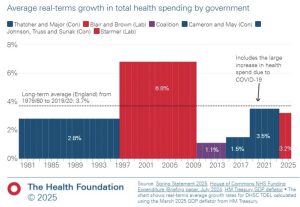The NHS is widely seen as having received a generous settlement in the recent spending review, compared to the settlements for other departments, such as policing and education. The settlement covers from 2026/27 to 2028/29 and gives the DHSC an overall 2.8% average annual increase in department spending, but within this NHS England, which covers day-to-day spending, will get a 3% increase.
Let’s put that ‘generous’ settlement in context.
The NHS has been underfunded for well over a decade and is facing multiple calls on its budget, including ever-increasing costs, pay deals, crumbling hospitals, a workforce crisis, and a population that is getting more and more unhealthy.
The cost of healthcare will always keep rising
The NHS exists in a world of ever-increasing healthcare costs, due to several factors that are not unique to the UK, including population growth; an ageing population, who typically use healthcare far more than younger people; rising expectations for treatment; and, unlike in other industries, new technology and innovations (medicines,drug delivery etc.) that do not reduce the cost of care, but are associated with higher costs. Added on to this the UK has seen over a decade of low investment and poor decisions in other areas that affect the health of the population, including housing, transport infrastructure, and the environment.
For a number of years health economists have calculated that annual funding needs to rise by at least 3-4% per year to maintain services. Anything less will lead to a managed decline in services, and only with more than 3-4% will there be a substantial improvement in quality across a broad range of services.

What has the NHS received in the past
Since the NHS’s launch in 1948 it has received an average of 3.6% increase in funding each year, although as the graph below shows the actual increases have varied with governments. The amounts the NHS has received have often been influenced by politics rather than need, with record rises at an average of 6.8% in the Labour years from 1997 to 2009 and record lows of 1.1% average in the coalition years from 2010 to 2014.
Both the Autumn budget, at 3.2%, and the Spending Review, at 2.8%, have given the DHSC total spending growth in real terms that falls short of the 3.6% average annual rise given to the NHS since its launch in 1948.
As well as being lower than the historical average the increases are also for an NHS that has experienced 15 years of underfunding.
Resolution of all pay disputes
Much of the money allocated in the Autumn budget has been spent on settling pay disputes. The money allocated in the spending review will also be used to settle pay disputes. NHS staff have seen years of below inflation pay rises and by the end of the Conservative’s time in government there were multiple strikes ongoing for higher pay from NHS staff, including nurses, resident doctors and consultants.
In July 2024 just after Labour came to power it entered pay settlements with staff unions. Across the NHS, those settlements averaged at around 5.5% for most staff groups, substantially higher than the 2% originally assumed in NHSE’s plans and funding level.
However, dissatisfaction continues following the announcement in 2025 of pay awards following review body recommendations.
There was a 5.4% average increase for resident doctors, formerly known as junior doctors, 4% for consultants and other senior doctors, and 3.6% for nurses and other health workers.
The British Medical Association (BMA) is threatening strike action and called the increase “derisory” and did not go far enough in reversing historical pay freezes.The RCN labelled the 3.6% as “grotesque” and is now balloting its members to determine its next steps.
The cost of delayed maintenance and repairs to England’s hospitals has rocketed
Another major call on spending is the state of NHS infrastructure. Over the entire 14 years of the Conservative government little was done to improve the infrastructure of the NHS. Low increases in capital investment plus lack of funding forced NHS trusts to raid capital budgets to fund day-to-day running. The result of this lack of action is that the NHS now has a massive bill for backlog maintenance. By the time the new Labour government was in power in 2024 the total backlog had rocketed to £13.8bn from £6bn in 2019. The number of trusts that face backlog bills of over £100m has climbed steadily.
It’s important to note that these are the estimates for overdue work to repair crumbling buildings and replace outdated and badly running equipment – but not to completely rebuild or replace buildings, even when they are riddled with the problem of RAAC concrete: those costs would be even higher.
The Autumn budget did bring some welcome news for capital spending, which rose an average of 10.9% in 2024/25 and 2025/26. But the spending review now effectively leaves the capital budget flatlining for three years from 2026/27 to 2028/29.
In a separate announcement, NHSE chief executive Sir Jim Mackey has said that the NHS was looking to introduce an “off–balance sheet capital investment mechanism” that could bring private finance into health service infrastructure.
A costly workforce crisis that needs to be solved
The NHS has a major staffing crisis, including nurses, midwives, doctors, support staff and GPs. Well over a decade of underinvestment in training new staff and lack of measures to retain existing staff has led to increased pressure on existing staff. As the work pressures increase and pay and conditions remain poor, staff leave, which then increases the pressure on remaining staff still further. The problem has escalated since the pandemic.
The NHS Staff shortages affect the safety and quality of care, but lack of staff also leads to increased costs due to spending on expensive agency staff.
In April 2025, the HSJ saw internal NHS England figures which revealed that providers were on course to spend £8.3bn on temporary staffing in 2024/25. Although this is down from just under £10bn in 2023/24.
Over the years the workforce crisis has not been helped by the NHS’s workforce being the major target of NHS organisations seeking the efficiencies required under government funding settlements.
This spending review is no different, requiring a 2% efficiency gain for the NHS. Without exception, NHS organisations have focused on staffing in recent years in order to meet efficiency targets. This has a knock-on effect on staff morale and patient safety.
Public health is the key to long-term health improvements
The Labour government’s forthcoming 10 year plan for the NHS aims to achieve three shifts in NHS services towards more community-based care, prevention of ill health and use of digital technology.
Funding for prevention of ill health, however, has been neglected for many years. The public health grant has been consistently cut since 2025/16 and it is now over 25% lower on a real-terms per person. To restore the grant to the real-terms equivalent of 2015/16 levels per person would require an additional £3.6bn over the Spending Review period, according to the Health Foundation.
The spending review was an opportunity to renew the public health grant and invest in improving the health of the nation. In the long-term such investment could reduce the ever-increasing cost of the NHS and have major economic benefits. Public health received a 3% uplift in the Autumn budget, but in the spending review it is among the DHSC areas whose budget will be squeezed due to the 3% increase for NHS England.
Finally, the NHS continues to have a waiting list for elective care of over 7 million, long waiting times for inadequate mental health care, over a quarter (25%) of all patients wait longer than 4 hours in A&E, and ambulance delays continue across the country. The spending review money is likely to disappear very quickly indeed.
Dear Reader,
If you like our content please support our campaigning journalism to protect health care for all.
Our goal is to inform people, hold our politicians to account and help to build change through evidence based ideas.
Everyone should have access to comprehensive healthcare, but our NHS needs support. You can help us to continue to counter bad policy, battle neglect of the NHS and correct dangerous mis-infomation.
Supporters of the NHS are crucial in sustaining our health service and with your help we will be able to engage more people in securing its future.
Please donate to help support our campaigning NHS research and journalism.


